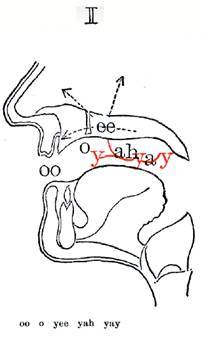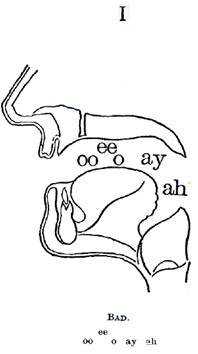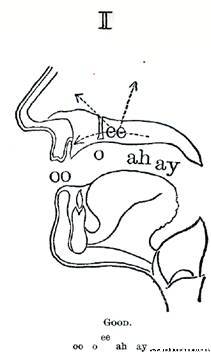| Share page | Visit Us On FB |
SECTION XXIV
THE POSITION" OF THE MOUTH (CONTRACTION OF THE MUSCLES OF SPEECH)
What must my sensations be with the
muscles of speech ? How shall I control
them?
The best position of the mouth, the means
of securing the proper use of the muscles of
speech and of the vocal organs, is established
by pronouncing the vowel a, not too sharply,
in the middle range of the voice, and trying
to retain the position of the muscles after
the sound has ceased.
This cannot be done without a smiling
position of the mouth, consequently with a
strong contraction of the muscles of the
mouth, tongue, and throat, which can be felt
to be drawn up as far as the ears.
In doing so the tongue — as far as the tip
192
THE POSITION OF THE MOUTH 193
— lies of a pretty nearly even height to the
|
arching, but rather somewhat depressed over
it.
In pronouncing the vowels a and e, the
bright vowels, the full stream of the breath,
in the given position, can only partly pass
between the tongue and the palate. The
other part is forced — unless the larynx
stands too high and can choke it off —
above the palate into the nasal cavities, to
seek its opportunity for resonance.
The path for a and e above the palate is
worthy of all attention as a place for the
overtones of the middle voice. If the soft
palate, in the lower middle tones, is forced
too far toward the hard palate, the covered
tones are without vibrancy. One must needs
secure the help of the nose especially, when
the palate is sunk beneath the nose, by in-
flating the nostrils and letting air stream
in and out of them.
194 HOW TO SING
I repeat the warning, not to force several
tones upon the same resonating point, but
to see that upon each tone the form nec-
essary for succeeding tones is prepared.
Neglect of this will sooner or later be paid
for dearly.
Notwithstanding the strong muscular con-
traction that the vocal organs must undergo
in pronouncing the vowel a, the breath must
be able to flow gently and without hindrance
through its form, in order completely to fill
up its resonance chambers. Again, and al-
ways, attention must be given that in sing-
ing, and in speaking as well, nothing shall
be cramped or held tense, except the press-
ure of the breath against the chest. It is
of the utmost importance to maintain this
position for all vowels, with the least pos-
sible perceptible modifications.
How can this be done ? A and e are
bright vowels, must be sung with a pleasant,
almost smiling, position of the mouth. V
and o, on the contrary, are dark vowels, for
THE POSITION OF THE MOUTH 195
which the lips must be drawn into a sort
of spout. Look at the position of the throat
in these vowels: (1) as they are usually sung
and spoken; (2) as I feel it, in singing, as
I sing them, and as they must be sung and
felt.
CONNECTION OF VOWELS
How do I connect them with each other?
If I wish to connect closely together two
vowels that lie near to or far from each
other, I must first establish the muscular con-
tractions for a, and introduce between the
two vowels, whether they lie near together
or far apart, a very well-defined y. Then
(supposing, for instance, that I want to con-
nect a and e) I must join the U closely to
the y, and the y closely to the e, so that
there is not the least resonating space be-
tween the two that is not filled during the
changes in the position of the organs, how-
ever carefully this is undertaken. There
must be no empty space, no useless escape
of breath, between any two of the sounds.
At first only two, then three and four, and
196
|
|
|
|
|
CONNECTION OF VOWELS 203
then all the vowels in succession must be so
practised: —
A-ye, a-ye-yu, a-ye-yoo-yu, a-ye-yo-yii-yu-ye-
yah.
But there must be never more than so
much breath at hand as is needed to make
the vowel and the tone perfect. The more
closely the vowels are connected with the
help of the y, the less breath is emitted from
the mouth unused, the more intimate is the
connection of tone, and the less noticeable are
the changes of the position of the organs in
relation to each other.
When I pass from ya-ye to yoo, I am com-
pelled to develop very strongly the muscular
contraction of the lips, which are formed into
a long projecting spout; and this movement
cannot be sufficiently exaggerated. With
every new y I must produce renewed mus-
cular contractions of the vocal organs, which
gradually, through continuous practice, are
trained to become almost like the finest, most
pliable steel, upon which the fullest reliance
204 HOW TO SING
may be placed. From yoo it is best to go to
yii, that lies still farther forward and requires
of the lips an iron firmness; then to yo, touch-
ing slightly on the e that lies above the o;
then return to ya, and not till then going to
ye-ah, which must then feel thus: —
e
oo-o ah-a
y
The y is taken under the ah, that the word
may not slide under; for usually the thought
of ah relaxes all the organs: the tongue lies
flat, the larynx becomes unsteady, is without
definite position, and the palate is not arched
and is without firmness. In this way ah be-
comes the most colourless and empty vowel of
the whole list.
With every change of vowel, or of any
other letter, there are changes in the posi-
tion of the organs, since tongue, palate, and
larynx must take different positions for differ-
ent sounds.
With a and is the larynx stands higher, the
palate is sunk, or in its normal position.
CONNECTION OF VOWELS 205
With oo, o, and ah the larynx stands low,
the palate is arched.
With a, e, and ah the lips are drawn back.
With oo, o, u, and o" they are extended far
forward.
The auxiliary sound y connects them all
with each other, so that the transitions are
made quite imperceptibly. Since it is pro-
nounced with the tongue drawn high against
the palate, it prevents the base of the tongue
from falling down again.
This should be practised very slowly, that
the sensations may be clearly discerned, and
that no vibration that gives the vowel its
pitch and duration may escape attention.
The muscular contraction described com-
prises the chief functions of the vocal organs,
and is as necessary for singing as the breath
is for the tone. Year in and year out every
singer and pupil must practise it in daily
exercises as much as possible, on every tone
of the vocal compass.
In the lowest as well as in the highest
206 HOW TO SING
range the sharpness of the a is lost, as well
as the clear definition of all single vowels.
A should be mingled with oo, ah, and e. In
the highest range, the vowels are merged
in each other, because then the principal
thing is not the vowel, but the high sound.
Even the thought of a and e, the latter
especially, raises the pitch of the tone. The
explanation of this is that a and e possess
sympathetic sounds above the palate that
lead the breath to the resonance of the head
cavities.
For this reason tenors often, in high notes,
resort to the device of changing words with
dark vowels to words with the bright
vowel e. They could attain the same end,
without changing the whole word, by simply
thinking of an e.
Without over-exertion, the singer can prac-
tise the exercises given above twenty times
a day, in periods of ten to fifteen minutes
each, and will soon appreciate the advan-
tage of the muscular strengthening they
|
CONNECTION OF VOWELS 209
give. They make the voice fresh, not
weary, as doubtless many will suppose.
What, then, can be expected of an un-
trained organ? Nothing! .
Without daily vocal gymnastics no power
of endurance in the muscles can be gained.
They must be so strong that a great oper-
atic role can be repeated ten times in suc-
cession, in order that the singer may become
able to endure the strain of singing in opera
houses, in great auditoriums, and make
himself heard above a great orchestra, with-
out suffering for it.
When I, for instance, was learning the
part of Isolde, I could without weariness
sing the first act alone six times in succes-
sion, with expression, action, and a full
voice. That was my practice with all my
roles. After I had rehearsed a role a thou-
sand times in my own room, I would go
into the empty theatre and rehearse single
scenes, as well as the whole opera, for hours
at a time. That gave me the certainty of
210 HOW TO SING
being mistress of my resonances down to
the last note; and very often I felt able to
begin it all over again. So must it be, if
one wishes to accomplish anything worth
while.
Another end also is attained by the same
exercise, — the connection, not only of the
vowels, but of all letters, syllables, words,
and phrases. By this exercise the form for
the breath, tone, and word, in which all the
organs are adjusted to each other with per-
fect elasticity, is gradually established. Slowly
but surely it assures greatest endurance in
all the organs concerned in speaking and
singing, the inseparable connection of the
palatal resonance with the resonance of the
head cavities. In this way is gained per-
fection in the art of singing, which is based,
not on chance, but on knowledge; and this
slow but sure way is the only way to
gain it.
By the above-described method all other
alphabetical sounds can be connected, and
CONNECTION OF VOWELS 211
exercises can be invented to use with it,
which are best adapted to correct the mis-
takes of pupils, at first on one, then step by
step on two and three connected tones, etc.
At the same 'time it is necessary to learn
to move the tongue freely, and with the ut-
most quickness, by jerking it back, after
pronouncing consonants, as quick as a flash,
into the position in which it conducts the
breath to the resonating chambers for the
vowels. With all these movements is con-
nected the power of elastically contracting
and relaxing the muscles.





